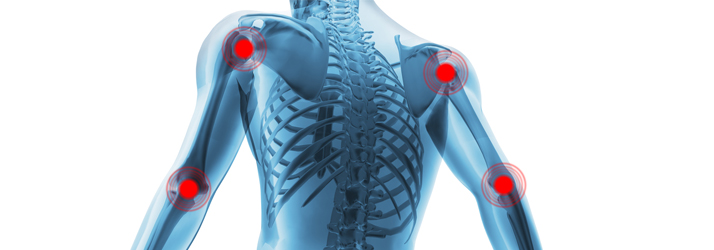Pain in Plano

When something is wrong with the body, the nervous system lets us know through pain, which presents differently depending on the injury or condition. It can feel sharp or dull, like a prick, sting or burn, or like a throbbing or ache. Descriptions along with the type of pain such as long-lasting pain (chronic) and sudden, short pain (acute) can help identify the specific injury or condition. Contact our Plano chiropractors to see how they can help you get back to living a pain-free life.
Here are a few of the different pains we see in the Plano office:
PLANTAR FASCIITIS
Plantar Fasciitis (PLAN-tur fas-e-I-tis) is one of the most common causes of heel pain. It involves pain and inflammation of a thick band of tissue, called the plantar fascia, which runs across the bottom of your foot — connecting your heel bone to your toes.
Plantar fasciitis (PF) causes stabbing pain that usually occurs with your very first steps in the morning. Once your foot limbers up, the pain of plantar fasciitis normally decreases, but it may return after long periods of standing or after getting up from a seated position. Plantar fasciitis is particularly common in runners. People who are overweight, women who are pregnant, and those who wear shoes with inadequate support, are at a higher risk of plantar fasciitis.
A Note from the Doctor: We have had great success treating plantar fasciitis in a limited number of visits. The treatment includes myotherapy, stretching, and rehabilitative exercises. With the treatment, we are able to break down the restricted tissue to create a better blood flow to the injury and allow it to heal in a quicker more efficient manner.
Many people that suffer from plantar fasciitis will seek podiatric or orthopedic specialists and opt for cortisone injections. This will help decrease the inflammation but is often described as “masking the pain” because it does not address the underlying problem. It can be a quick way to relieve the pain associated with plantar fasciitis and depending on the individual can have a long-lasting effect. Orthotics and night splints are often prescribed as well.
GOLFER’S ELBOW
TENNIS ELBOW
SHIN SPLINTS
NECK PAIN
LOW BACK PAIN
FROZEN SHOULDER/ADHESIVE CAPSULITS
TENSION HEADACHES/MIGRAINES
SCIATICA
TMJ
HIP PAIN
OFFICE HOURS
Monday
8:00am - 5:00pm
Tuesday
8:00am - 5:00pm
Wednesday
8:00am - 5:00pm
Thursday
8:00am - 5:00pm
Friday
8:00am - 2:30pm
Saturday & Sunday
Closed
The Tx Room
2845 Parkwood Blvd #200
Plano, TX 75093
TEXT OR CALL: (972) 781-2800
F: (972) 608-9680
frontdesk@thetxroom.com



